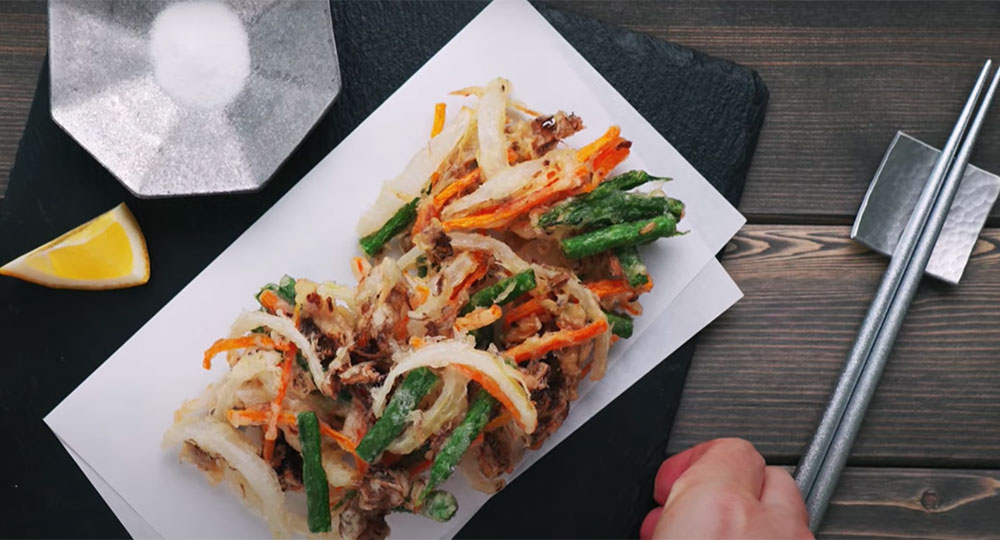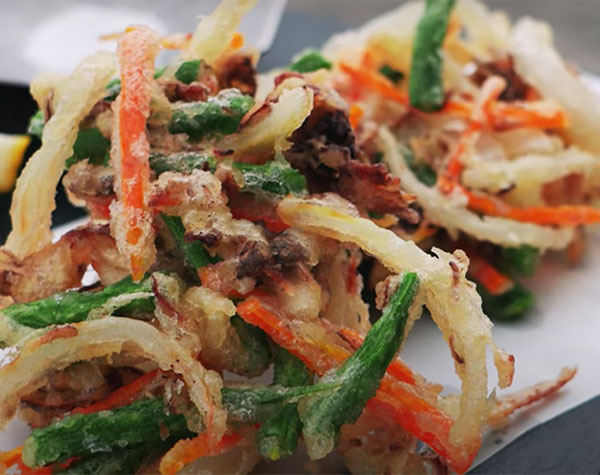
Ulundu Vadai: A Delightful Addition to Vegetarian Recipes
August 4, 2024
Indian Puri: A Staple in Vegetarian Recipes
August 7, 2024
Ulundu Vadai: A Delightful Addition to Vegetarian Recipes
August 4, 2024
Indian Puri: A Staple in Vegetarian Recipes
August 7, 2024
Kakiage: A Highlight in Vegetarian Recipes
In the diverse world of vegetarian cuisine, Japanese culinary traditions offer a wealth of flavorful and innovative dishes. Among these, Vegetable Tempura, particularly the variant known as Kakiage, stands out as a beloved classic. Kakiage is a type of mixed vegetable tempura that is cherished for its light, crispy texture and the harmonious blend of vegetables it encompasses. This dish exemplifies the elegance and simplicity of Japanese cooking while fitting perfectly into the repertoire of vegetarian recipes.
30 mins
Easy
Serves 4
The Art of Kakiage
Kakiage is a unique form of tempura where various vegetables are julienned, mixed together, and fried in a light batter. This method allows for a symphony of flavors and textures in each bite, making it a delightful addition to any vegetarian meal. Common vegetables used in Kakiage include carrots, onions, sweet potatoes, bell peppers, and green beans, though the selection can vary based on seasonal availability.
The Tempura Batter
The key to perfect Kakiage lies in the tempura batter, which should be light and airy to create a crispy coating. The batter is traditionally made from ice-cold water, flour, and sometimes a touch of egg. The cold temperature of the water is crucial as it helps to keep the batter from absorbing too much oil, resulting in a crisp texture. For a fully vegetarian version, the egg can be omitted without sacrificing the quality of the dish.
Frying Technique
The vegetables are julienned into thin strips, mixed together, and lightly coated with the batter. Small handfuls of the vegetable mixture are then gently dropped into hot oil and fried until golden brown. The frying process is quick, ensuring that the vegetables remain tender inside while developing a crisp exterior. The finished Kakiage pieces are drained on paper towels to remove excess oil.
Complementary Elements
Kakiage is often served with a variety of accompaniments that enhance its flavors and provide a balanced meal.
Dipping Sauce
A traditional dipping sauce called tentsuyu, made from dashi, soy sauce, and mirin, is commonly served alongside Kakiage. This sauce adds a savory depth to the dish, perfectly complementing the light, crispy tempura. For those adhering to a strict vegetarian diet, dashi made from kombu (kelp) rather than bonito flakes can be used to keep the sauce vegetarian-friendly.
Rice and Miso Soup
Kakiage can be served as part of a larger meal, accompanied by steamed white rice and miso soup. The rice acts as a neutral base, while the miso soup, made from fermented soybean paste, tofu, seaweed, and green onions, adds a comforting, umami-rich element. Together, they create a well-rounded and satisfying meal.
Pickled Vegetables
Pickled vegetables, or tsukemono, provide a tangy contrast to the rich flavors of the tempura. These pickles, which can include radishes, cucumbers, and plums, help cleanse the palate and add a refreshing crunch to the meal.
Nutritional Benefits
A Versatile Vegetarian Recipe
Conclusion
Vegetable Tempura (Kakiage) is a shining example of how traditional Japanese cuisine can be incorporated into modern vegetarian recipes. Its light, crispy texture, and the vibrant flavors of mixed vegetables create a dish that is both satisfying and nutritious. As more people explore vegetarian options, Kakiage offers a delightful way to experience the rich culinary heritage of Japan while adhering to a plant-based diet. This timeless dish continues to be a favorite for its simplicity, versatility, and the joy it brings to the dining table.
How to cook Vegetable Tempura (Kakiage)?
Cooking Vegetable Tempura (Kakiage) at home is a rewarding experience that allows you to enjoy this delicious Japanese dish fresh and crispy. Here's a step-by-step guide to help you make perfect Kakiage:
Ingredients:
For the Batter:
- 1 cup all-purpose flour
- 1 cup ice-cold water
- 1 egg (optional, can be omitted for a vegan version)
- A pinch of salt
For the Kakiage:
- 1 small carrot, julienned
- 1 small sweet potato, julienned
- 1/2 onion, thinly sliced
- 1/2 bell pepper, julienned
- A handful of green beans, cut into thin strips
- Vegetable oil for frying
For the Dipping Sauce (Tentsuyu):
- 1 cup dashi (or vegetarian dashi made from kombu)
- 1/4 cup soy sauce
- 1/4 cup mirin
- Grated daikon radish (optional)
Instructions:
-
Prepare the Vegetables:
- Wash and peel the vegetables as necessary.
- Julienne the carrot, sweet potato, and bell pepper.
- Thinly slice the onion.
- Cut the green beans into thin strips.
- Mix all the prepared vegetables in a large bowl.
-
Make the Batter:
- In a separate bowl, beat the egg (if using) and mix it with the ice-cold water.
- Add the flour and a pinch of salt to the liquid mixture.
- Gently mix the batter with chopsticks or a fork until just combined. It’s okay if there are a few lumps; over-mixing will make the batter heavy.
-
Heat the Oil:
- In a deep frying pan or pot, heat the vegetable oil to 340-350°F (170-180°C). Use a thermometer to maintain the temperature.
-
Mix the Vegetables with Batter:
- Add a small amount of batter to the mixed vegetables to coat them lightly. The vegetables should stick together but not be overly wet with batter.
-
Fry the Kakiage:
- Using a spoon or your hands, take small mounds of the vegetable mixture and gently place them into the hot oil.
- Fry in batches to avoid overcrowding the pan. Each piece should be about the size of a small fist.
- Fry until golden brown and crispy, about 3-4 minutes per side.
- Use a slotted spoon to remove the Kakiage from the oil and place it on paper towels to drain excess oil.
-
Prepare the Dipping Sauce:
- In a small saucepan, combine the dashi, soy sauce, and mirin.
- Bring to a gentle boil and then turn off the heat.
- Let the sauce cool slightly. Serve with grated daikon radish if desired.
-
Serve:
- Serve the hot Kakiage immediately with the dipping sauce on the side.
- Enjoy your Vegetable Tempura (Kakiage) with steamed rice and miso soup for a complete meal.
Tips for Perfect Kakiage
- Cold Batter: Ensure the batter is ice-cold. This helps create a light and crispy texture.
- Hot Oil: Maintain the oil temperature at 340-350°F (170-180°C) for even frying.
- Thin Vegetables: Cut the vegetables into thin, uniform strips to ensure they cook evenly.
- Minimal Batter: Use just enough batter to hold the vegetables together. Too much batter can make the tempura heavy.
By following these steps, you'll be able to create a delicious and authentic Vegetable Tempura (Kakiage) that can be enjoyed as part of a vegetarian meal or a delightful snack.

